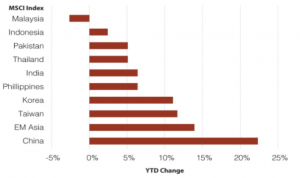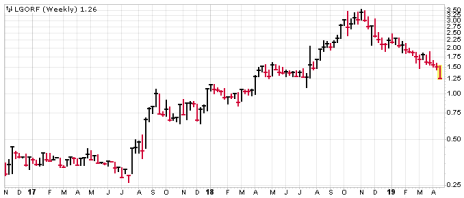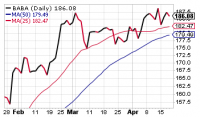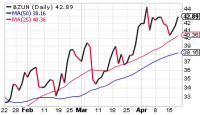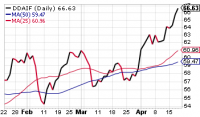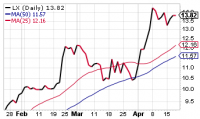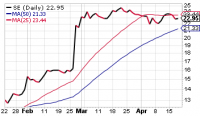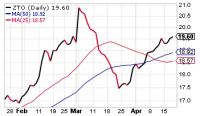Emerging markets have stayed strong into the second quarter, with China leading the way and calming markets by delivering 6% economic growth.
Inside this issue is a new recommendation with a play on a market some estimate as large as $94 trillion over the next two decades. The company delivers a key ingredient that turns steel into “super steel” and plays a key role in electrifying the grid.
Cabot Emerging Markets Investor 683
[premium_html_toc post_id="175380"]
Cabot Emerging Markets Timer
The Emerging Markets Timer is our disciplined method for staying on the right side of the emerging markets. The Timer is bullish when the index is above the lower of its two moving averages and that moving average is trending up.
Our Emerging Markets Timer remains bullish, as it has since mid January, with the intermediate-term uptrend reaccelerating over the past couple of weeks. The iShares EM Fund (EEM) wobbled for two months and tested its lower (50-day) moving average twice in March, but each time it held where it had to, and so far in April, the buyers have pushed the fund to multi-month highs.
Of course, there remain many uncertainties out there, and after a three-and-a-half month uptrend, further pullbacks are always possible. But it’s best just to go with the evidence in front of us. Right now, that evidence is bullish, so you should remain heavily invested.
A $94 Trillion Emerging Opportunity
Emerging markets are staying on track, and our EEM signal is positive.
While many, including me, are generally skeptical of Chinese government statistics, it looks like the Chinese economy grew at about 6.4% in the first quarter after Beijing flooded the financial system with money to avoid a slowdown.
The chart below based on Bloomberg data highlights how Chinese stocks have snapped back nicely after a sharp pullback in 2018.
This chart indicates that these other markets could now benefit from some “catch-up” growth.
Keep in mind that there is a group of emerging markets that are considered as proxies for commodities. So when commodities are down and the political climate unfavorable, some of these economies can shrink.
For example, India and China’s economies grew 48% and 79%, respectively, between 2011 and 2018, whereas Brazil’s, South Africa’s and Russia’s economies shrank by double digits. But when these markets come back, they can form a strong and enduring uptrend.
As the U.S. and China (finally) look to wrap up trade talks, European negotiators have received the green light to begin negotiations with the U.S. after both sides have threatened each other with billions of dollars in new tariffs over an aviation dispute.
The EU is trying to do its own limited deal with America to address tariffs on industrial goods, in part to avoid levies President Trump has threatened on foreign automobiles and car parts.
Finally, Japan this week also steps into bilateral U.S. trade talks as Shinzo Abe aims to avoid tariffs or quotas on auto exports and Trump attempts to crack open Japan’s agricultural market and reduce a $60 billion trade deficit.
Good luck with that one.
Enough on trade; I have a new recommendation related to an even bigger and more important opportunity.
Does $94 trillion get your attention?
Featured Stock
New Recommendation: Largo Resources (LGORF)
A Key Infrastructure Play & Critical Material for Electrifying the Grid
When you arrive for the first time in a country, what is the first thing you notice?
Maybe how modern the airport is, then the condition of the subway or roads, bridges and the buildings you pass on the way to your hotel.
This is infrastructure.
And the probability is high that much of this infrastructure shares one hidden ingredient that will make you a lot of money.
It goes well beyond making an impression on visitors – it is the very foundation and backbone of a modern economy.
Infrastructure is also a very capital-intensive big business presenting a great opportunity for savvy investors.
And keep in mind that like many things in life, looks can be deceiving.
I vividly recall a friend of mine who heads up an investment firm returning from a trip to Shanghai in the 1990s and saying, “You see construction cranes everywhere but the stuff they’re putting up looks like junk to me.”
Infrastructure includes big stuff such as roads, oil and gas projects, telecommunications, satellites, bridges & tunnels, pipelines, airports & seaports, power plants, railways, subways, and water supply and treatment facilities.
The joint Global Infrastructure Hub and Oxford Economics report estimates that total spending on infrastructure will be $94 trillion in the next two decades.
That’s a staggering figure.
To put it in perspective, this number is considerably more than total world GDP in 2018 – and more than four times America’s total economic output in 2018.
And in just the next five years, some experts expect the amount of cash injected into global infrastructure to reach $26 trillion, or more than the annual GDP of the U.S., Canada and Mexico combined.
As emerging market investors, we need to follow the money for the best opportunities. And that’s why our new recommendation is Largo Resources (LGORF), which produces an ingredient that turns ordinary steel into “super steel” and is playing an increasingly important role in electrifying the grid.
Largo is a strategic mineral company focused on the production of vanadium flake, high-purity vanadium flake and high-purity vanadium powder at the Maracás Menchen Mine located in Bahia State, Brazil.
Headquartered in Toronto, Largo’s stock has been on a bit of a rollercoaster lately.
Its product is primarily vanadium, a rare and strategic metal critical to steel strengthening, titanium-vanadium super alloys for aerospace and as a critical material for large grid energy storage batteries important to electrifying the grid.
Vanadium (or vanadium pentoxide flakes) prices soared in 2018, peaking at $34 a pound in November. As vanadium prices have gone up, so has Largo’s share price.
During the past year, LGORF went from 1.09 to a high of 3.39 on November 5, 2018. Since then it has come crashing back to earth, trading at a mere 1.39 per share as of this writing, or about 5.3 times trailing earnings.
This is obviously not a momentum play but rather a special situation value play.
First, let me take a step back and tell you a bit more about vanadium.
Vanadium is found in iron ore magnetite normally with titanium but in very small amounts, which is why it is classified as a rare, strategic metal.
Until recently, vanadium had two primary uses: as a steel strengthener and, in combination with titanium, as a critical super alloy for aerospace.
Just a dollop of vanadium added to steel doubles its strength and reduces its weight by 30%.
About 80,000 tons of vanadium are produced per year, with China accounting for about half of production followed by Russia, South Africa and then Brazil (all emerging markets).
Higher Standards for Steel Infrastructure Boost Vanadium Demand
Why did vanadium soar in 2018?
First, China, which had been using subpar quality steel for its infrastructure, finally began enforcing higher standards for its steel rebar – the skeleton for most buildings and other infrastructure.
The market viewed this move as a major catalyst for vanadium demand. Some analysts believe it added at least 10,000 tons of annual demand. Other emerging markets are likely to follow China’s lead, propelling demand even higher than that.
That’s no surprise, given that steel represents the core of new infrastructure projects around the world.
Vanadium Redox Flow Batteries a Significant New Source of Demand
Right now, about 97% of vanadium consumption is for strengthening steel and as a super alloy for aviation, but there is a growing awareness of a new application critical to electrifying the grid.
This application is called vanadium redox flow batteries and they are emerging as a keen competitor for lithium ion batteries as the foundation for large-scale grid energy storage.
What this means is pretty simple: If we are going to depend more on renewable energy, we are going to have to be able to store the generated electrical energy so that we can use it when we need it.
Right now lithium batteries are in the driver’s seat but the vanadium-based batteries have clear advantages, including storage periods that last longer than four hours, plus fewer safety and contamination issues.
Leading consultants estimate that the large-grid energy storage market will grow to a $50 billion business over the next five years and that vanadium batteries could capture as much as a 20% market share. That translates to a 36% compounded annual growth rate for vanadium batteries. In addition, vanadium represents about 40% of the total cost of these vanadium redox flow batteries.
The combination of China steel rebar upgrades and the vanadium battery story hitting the headlines is what drove vanadium in 2018. However, when everyone realized prices had gotten ahead of the fundamentals, the sharp pullback in prices and Largo’s stock price began.
What now?
While in London last week, I met with a number of mining and resource specialists. The consensus was that the demand story for vanadium was compelling, but the supply side a bit murky.
They expect that vanadium will settle somewhere around $25 a pound, or 65% above current prices. Largo’s stock, which largely already reflects current prices, should follow the price of vanadium, much like gold mining stocks follow the price of gold and silver miners move in tandem with silver prices.
But there will be some challenging earnings comparisons in 2019.
You see, 2018 was a banner year for Largo, with net income of $316 million and net revenue up 211% over 2017. Vanadium production also set a record at 9,800 tons. That strong performance put the company on a path to completely eliminate debt, giving it a cash position of $206 million.
As the world’s lowest-cost producer of vanadium, Largo seems undervalued right now at less than six times trailing earnings.
I recommend buying only a small position right now while we wait for first-quarter numbers to roll in. I will become more aggressive as the stock develops an uptrend, or at prices below 1.30 a share.
Either way, our target price is 2.00 a share—60% higher than its current price. BUY A SMALL POSITION
Largo Resources (LGORF)
55 University Avenue
Suite 1101
Toronto, ON M5J 2H7
Canada
http://www.largoresources.com
Model Portfolio
Prices as of 2:30pm
Updates
Alibaba (BABA) tacked on another small gain this past week and continues to build on its strengths.
Alibaba, with revenue exceeding $50 billion in 2018, operates as a near monopoly through revenue-share model “ecosystem” retailing platforms, namely the Taobao Marketplace, China’s largest online consumer-to-consumer shopping site; Tmall, China’s largest third-party business-to-consumer platform for branded goods; and Juhuasuan, China’s most popular group buying marketplace.
The Wall Street Journal reports that the Tmall website operated by Alibaba has attracted brands including Valentino, Bottega Veneta and Burberry.
Even as the luxury brands have snubbed Amazon, they seem to be embracing Alibaba as a platform to grow their businesses in a high potential, low familiarity market.
We believe that BABA remains a great core China holding. BUY A HALF.
Baozun (BZUN) ended the week in an uptrend and should be one of the primary beneficiaries of a U.S.-China trade deal.
On the valuation side, the stock appears a bit expensive based on earnings. But the company expects $1 billion in revenue for 2019 yet has a market value of only $2.2 billion. I like that ratio. BUY A HALF.
Daimler (DDAIF) keeps grinding out incremental gains as a high-quality, conservative play on emerging markets. As a bonus, enjoy the 7.5% dividend yield.
There are rumors at the Shanghai Auto Show this week that Mercedes-Benz may team up with BMW on compact car development. Mercedes-Benz maintains its market leadership in the premium segment in Germany, the U.K., France, Italy, Switzerland, Sweden, Portugal, Poland, Denmark, South Korea, Australia, Canada, Brazil and other markets. That bodes well for Daimler. BUY A HALF.
LexinFintech (LX), our latest recommendation, is doing well.
This high-growth fintech idea is currently trading at a very reasonable valuation and, if you don’t own any, I encourage you to build a half position. BUY A HALF.
Sea Limited (SE) stock has experienced some profit taking after a 40%-plus surge in March.
While SE is burning through more cash than we would like, the company’s digital entertainment segment saw revenues climb 63% to reach $241 million in the latest quarter. Growth for the company’s online retail business was even faster.
If you bought on our recommendation, you may want to book some profits but you can hold the rest. If you have not yet invested in SE, I’m not opposed to nibbling here if you really want in, but prefer waiting for dips for more aggressive buying. HOLD A HALF.
TAL Education (TAL) has been largely treading water during the past month. There’s been no negative news but the relative underperformance is the reason I’m deciding to sell. We will surely find another China idea with more momentum. MOVE FROM HOLD TO SELL.
Tencent (TCEHY) has broken above 50 and is within striking distance of new recovery highs.
Despite the surge, its valuation seems reasonable relative to competitors. On ride-hailing, Tencent, Alibaba, and other partners are teaming up for a decent chance to grab some market share from Didi, the indisputable leader after Uber pulled out of the Chinese market.
In the deal, touted to be worth about $1.5 billion, the partnership will create a ride-hailing and new-energy vehicle joint venture led by state-owned automakers. BUY A FULL POSITION.
Van Eck Rare Earths/Strategic Metals (REMX) moved ahead this week helped in part by a buyout offer from Lynas. REMX remains a hedge against U.S.-China tensions and a play on rare metals and rare earths that are undervalued and underappreciated given their importance to high-tech products and markets. HOLD A HALF.
ZTO Express (ZTO) was up marginally this week but has underperformed overall, sitting just about where it was a month ago after posting 2018 earnings. This is a bit frustrating given its strong performance across the board.
Based in Shanghai, ZTO is one of the largest express delivery companies, not just in China but globally. It offers services to millions of traditional merchants, e-commerce sites and online sellers covering 96% of China’s cities and counties.
The company increased its leading position in China’s express delivery industry with a market share of 16.8%. Parcel volume rose by 37.1%. (ZTO delivered 8.52 billion packages in 2018.)
On-time deliveries, complaint resolution and customer satisfaction all rank among the top in the industry. It now owns and operates over 4,500 trucks, including 2,800 high-capacity vehicles.
ZTO is building an enormous, scalable platform based on automated sorting equipment that will further increase efficiencies and lower costs. Yet despite its prodigious growth, ZTO Express still trades near its IPO price from two and a half years ago. This is likely to change.
Finally, ZTO’s board has authorized a new $500 million share repurchase program. If you are not yet on board, I encourage you to buy a half position right here. The next earnings report is expected May 15. BUY A HALF.
Watch List
NIO (NIO) appears to have settled down a bit but the bull and bear cases made in the financial press are sharply divided. NIO is previewing a new sedan at the Shanghai Auto Show this week that will add to its existing ES 6 and ES 8, but has not yet set a launch date.
[premium_html_footer]
Send questions or comments to paul@cabotwealth.com.
Cabot Emerging Markets Investor • 176 North Street, Salem, MA 01970 • www.cabotwealth.com
All Cabot Emerging Markets Investor buy and sell recommendations are made in issues or updates and posted on the Cabot subscribers’ website. Sell recommendations may also be sent to subscribers as special alerts via email. To calculate the performance of the hypothetical portfolio, Cabot “buys” and “sells” at the midpoint of the high and low prices of the stock on the day following the recommendation. Cabot’s policy is to sell any stock that shows a loss of 20% in a bull market (15% in a bear market) from our original buy price, calculated using the current closing (not intra-day) price. Subscribers should apply loss limits based on their own personal purchase prices.
THE NEXT CABOT EMERGING MARKETS INVESTOR ISSUE IS SCHEDULED FOR May 2, 2019
We appreciate your feedback on this issue. Follow the link below to complete our subscriber satisfaction survey: Go to: www.surveymonkey.com/chinasurvey
Cabot Emerging Markets Investor is published by Cabot Wealth Network, an independent publisher of investment advice since 1970. Neither Cabot Wealth Network, nor our employees, are compensated in any way by the companies whose stocks we recommend. Sources of information are believed to be reliable, but they are in no way guaranteed to be complete or without error. Recommendations, opinions or suggestions are given with the understanding that subscribers acting on information assume all risks involved. © Cabot Wealth Network 2019. Copying and/or electronic transmission of this report is a violation of the copyright law. For the protection of our subscribers, if copyright laws are violated, the subscription will be terminated. To subscribe or for information on our privacy policy, visit www.cabotwealth.com, write to support@cabotwealth.com or call 978-745-5532.
[/premium_html_footer]





